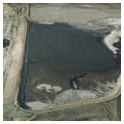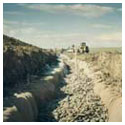|
|
Project Management |
Our managers and engineers have successfully managed projects requiring a single engineer or geologist to those requiring large, multi-disciplinary teams concerned with all major phases of mine development and operations. Our project management approach contains four distinct steps:
- Problem assessment
- Development of alternative solutions
- Selection of appropriate solution based on effectiveness and costs
- Monitoring of results
|
Project Name
|
Project Location
|
Client / Division
|
|
AML Projects 16-C Uranium Reclamation
|
Gas Hills Fremont County, Wyoming
|
Wyoming Department of Environmental Quality; Land Quality
Division
|
|
David H. Scriven was project manager for the reclamation
of the North Rex and Utah Pits and the Rox, Thunderbird and Atlas-Peach
Underground uranium mines. He was responsible for subsurface geotechnical
investigations, reclamation designs and bid document preparation.
He coordinated the work of several sub-consultants performing ground
and surface water studies, geomorphologic investigations, wildlife
and plant studies, radiometric surveys and revegetation designs.
|
|
Project Name
|
Project Location
|
Client / Division
|
|
Riley Pass Reclamation Project
|
Hardin County, South Dakota
|
Custer National Forest
|
|
David H. Scriven was project manager for the investigation
and design for the reclamation of the Riley Pass Uranium Mine, Hardin
County, South Dakota. He managed a team of soil scientists, geomorphologists,
biologists and health physicists to develop design alternatives
for the project. The Riley Pass Mine was a surface mine, circa late
1950's, mining uranium associated with a thin coal seam overlying
the rimrock. Spoil material was pushed over the rimrock creating
an unstable and highly erosive surface. Several highwalls were left
standing and ponded areas were created in the spoil piles. The project
included the development of several reclamation alternatives. The
alternatives were presented to the client to determine the one most
suitable to their needs. Final design and bid documents were then
prepared for the reclamation.
|
|
Project Name
|
Project Location
|
Client / Division
|
|
Pond 4 Rehabilitation
|
Sweetwater County, Wyoming
|
General Chemical Corporation
|
|
David H. Scriven was project manager for the rehabilitation
of the Pond 4 embankments. The embankments were severely eroded
from wave and wind action. The assignment included determining the
physical characteristics of the fill material and measuring compaction
of replaced fill. Construction management also included making major
design changes for the upstream slope protection.
|
|
Project Name
|
Project Location
|
Client / Division
|
|
Pond 5 Enlargement
|
Sweetwater County, Wyoming
|
General Chemical Corporation
|
|
David H. Scriven was project manager for the design
modification, permitting and construction for the enlargement of
Pond 5. The design modifications included designing a chimney drain,
realignment of the embankment, design of spillway and upstream slope
protection. Permitting included State Engineer's Permit, and construction
permits for the Wyoming Department of Environmental Quality, Water
Quality Division. Construction management included all construction
surveying, compaction testing, construction review, and development
of as-built drawings.
|
|
Project Name
|
Project Location
|
Client / Division
|
|
Solid Waste Disposal Cell D
|
Sweetwater County, Wyoming
|
Modification General Chemical Corporation
|
|
  David H. Scriven was project manager and project engineer
for modification of the Tailings Disposal Cell D Reservoir. The
modification project included several phases of construction of
a retrofit on an existing tailings disposal facility using upstream
and downstream construction methods. The assignment included design,
permitting and construction management for the project. Permitting
included application for the State Engineer's Permit and Construction
Permit from the Water Quality Division, Wyoming Department of Environmental
Quality. The first phase of this project was completed in 1990,
a second phase in 1992, a third phase in 1996. The fourth phase
is scheduled for 2000 and the final phase is scheduled for 2004.
The designs include a rotating multi-point discharge to facilitate
the use of sub-aerial deposition and the design of decant structures.
David H. Scriven was project manager and project engineer
for modification of the Tailings Disposal Cell D Reservoir. The
modification project included several phases of construction of
a retrofit on an existing tailings disposal facility using upstream
and downstream construction methods. The assignment included design,
permitting and construction management for the project. Permitting
included application for the State Engineer's Permit and Construction
Permit from the Water Quality Division, Wyoming Department of Environmental
Quality. The first phase of this project was completed in 1990,
a second phase in 1992, a third phase in 1996. The fourth phase
is scheduled for 2000 and the final phase is scheduled for 2004.
The designs include a rotating multi-point discharge to facilitate
the use of sub-aerial deposition and the design of decant structures.
|
|
Project Name
|
Project Location
|
Client / Division
|
|
Glenrock Subsidencse Control Project 8A
|
Converse County, Wyoming
|
Wyoming Department of Environmental Quality Land Quality
Division
|
|
The Town of Glenrock is underlain by two abandoned underground
coal mines which are causing subsidence events on the surface. This
project included a report of investigation to determine the most
cost-effective approach to subsidence control, the design of a slurry
backfill system to pump a sand/water mixture into the mine voids
through boreholes, the generation of bid documentation and construction
specifications and the construction management of the project for
the State of Wyoming. Notable requirements of the project included
design of a 3,000 gpm, 4,000 foot long slurry and water pipe line
system; design of a 5,000 gpm water supply well field; design of
a 200 foot span pipe bridge; roadway, sedimentation pond and drainage
control designs and grouting designs for structures and a 1,000
foot unstable segment of a state highway. David H. Scriven was part
of the construction management team for this project.
|
|
Project Name
|
Project Location
|
Client / Division
|
|
Northside Mine Subsidence Study
|
Gallup, New Mexico
|
Alan K. Kuhn, Consultant and Abandoned Mine Land Bureau
State of New Mexico
|
|
David H. Scriven was the subsidence investigation specialist
on the A.K. Kuhn team for the Northside Mine Subsidence Study in
Gallup, New Mexico. His assignments included interviews/workshops
with citizens; assistance to the State in locating subsurface investigation
boreholes; assistance in structure investigations; drilling supervision
and borehole logging; data analysis to define subsidence risk areas
and subsidence mechanisms; evaluations of remedial actions.
|
|
Project Name
|
Project Location
|
Client / Division
|
|
Design and Construction Seepage Interceptor Trench
|
Green Riven, Wyoming
|
Tenneco Company
|
|
 WSMC provided investigation, design engineering, construction
management as well as being general contractor for the construction
of a 2000 by 17 feet deep interceptor trench to collect seepage
from an adjacent evaporation pond. The trench was designed using
HDPE slotted pipe, gravel and geosynthetic filter fabric installed
to a depth deep enough to be keyed into low permeable bed rock.
The trench was tied into an existing sump which was rehabilitated
in the project. WSMC provided investigation, design engineering, construction
management as well as being general contractor for the construction
of a 2000 by 17 feet deep interceptor trench to collect seepage
from an adjacent evaporation pond. The trench was designed using
HDPE slotted pipe, gravel and geosynthetic filter fabric installed
to a depth deep enough to be keyed into low permeable bed rock.
The trench was tied into an existing sump which was rehabilitated
in the project.
|
|
Project Name
|
Project Location
|
Client / Division
|
|
Shaft Grouting Ventilation Shaft 4
|
Green River, Wyoming
|
General Chemical Corporation
|
|
WSMC provided design and construction management for
the grouting of Shaft 4 to eliminate groundwater seepage into the
ventilation shaft. The shaft had a requirement to be nearly dry
to prevent ice from building up on the shaft liner and also to prevent
decahydrate forming stalactites on the shaft liner. Both the ice
and decahydrate formations could create a safety hazard in the mine
below. The grout design for this project was a low viscosity, two
part chemical grout capable of sealing relatively tight sandstones.
Initial flow into the shaft was measured at approximately two gallons
per minute and after grouting was measured at approximately 18 ounces
per minute. Upon opening up the shaft and allowing full air flow,
the shaft was completely dry.
|
|
Project Name
|
Project Location
|
Client / Division
|
|
Due Diligence Environmental Invesstigation
|
Casper, Wyoming
|
Malapai Resources
|
|
David H. Scriven was the project manager for the due
diligence environmental investigation at the Iragaray and Christensen
Ranch in-situ uranium sites and the Willow Creek research and development
site. The investigation was completed prior to the sale of Malapai
Resources to Total. The project included complete testing and environmental
assessment of all plants, ponds and leach fields. Staff included
wide variety of engineering and scientific disciplines to cover
all aspects of the environmental assessment of the site including
health physicists, biologists, hydrologists, soil scientists and
environmental engineers.
|
|
|



 David H. Scriven was project manager and project engineer
for modification of the Tailings Disposal Cell D Reservoir. The
modification project included several phases of construction of
a retrofit on an existing tailings disposal facility using upstream
and downstream construction methods. The assignment included design,
permitting and construction management for the project. Permitting
included application for the State Engineer's Permit and Construction
Permit from the Water Quality Division, Wyoming Department of Environmental
Quality. The first phase of this project was completed in 1990,
a second phase in 1992, a third phase in 1996. The fourth phase
is scheduled for 2000 and the final phase is scheduled for 2004.
The designs include a rotating multi-point discharge to facilitate
the use of sub-aerial deposition and the design of decant structures.
David H. Scriven was project manager and project engineer
for modification of the Tailings Disposal Cell D Reservoir. The
modification project included several phases of construction of
a retrofit on an existing tailings disposal facility using upstream
and downstream construction methods. The assignment included design,
permitting and construction management for the project. Permitting
included application for the State Engineer's Permit and Construction
Permit from the Water Quality Division, Wyoming Department of Environmental
Quality. The first phase of this project was completed in 1990,
a second phase in 1992, a third phase in 1996. The fourth phase
is scheduled for 2000 and the final phase is scheduled for 2004.
The designs include a rotating multi-point discharge to facilitate
the use of sub-aerial deposition and the design of decant structures. WSMC provided investigation, design engineering, construction
management as well as being general contractor for the construction
of a 2000 by 17 feet deep interceptor trench to collect seepage
from an adjacent evaporation pond. The trench was designed using
HDPE slotted pipe, gravel and geosynthetic filter fabric installed
to a depth deep enough to be keyed into low permeable bed rock.
The trench was tied into an existing sump which was rehabilitated
in the project.
WSMC provided investigation, design engineering, construction
management as well as being general contractor for the construction
of a 2000 by 17 feet deep interceptor trench to collect seepage
from an adjacent evaporation pond. The trench was designed using
HDPE slotted pipe, gravel and geosynthetic filter fabric installed
to a depth deep enough to be keyed into low permeable bed rock.
The trench was tied into an existing sump which was rehabilitated
in the project.